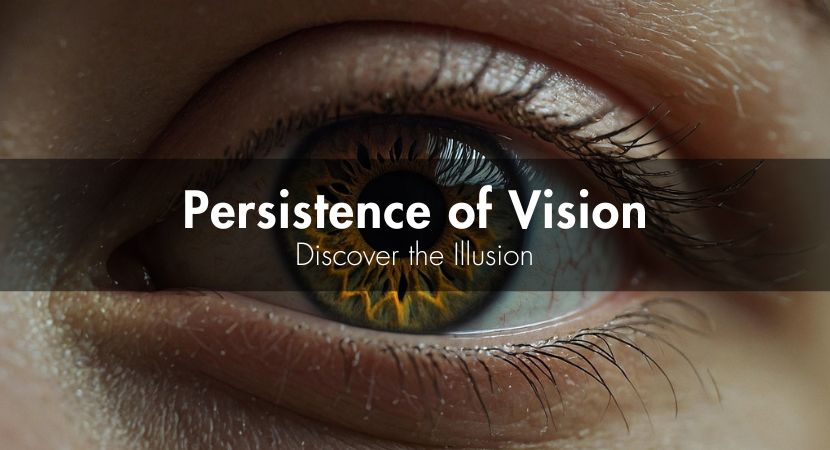
Motion in animation and film is radically an illusion — one that has fascinated viewers for over a decade. This illusion is inspired by an enthralling neurological effect called persistence of vision. The idea behind this phenomenon is to make still images appear moving when displayed in quick succession, whether it is a spinning top or a modern 3d animation.
In this article, we are going to define persistence of vision, what it is, its meaning, how it functions, its significance in history, animation, cinematography, and the future of immersive media.
Persistence of Vision Definition
Let's look at the definition of persistence of vision, which is the visual illusion of movement that happens when several static pictures merge in the human brain, resulting in the impression of smooth movement. Also known as retinal persistence, this is the basis for human perception of motion.
To explain the persistence of vision examples, consider that when we watch a sequence of fast-moving pictures, our mind keeps each picture in view for a fraction of a second, even after it has vanished. This overlap allows the mind to process individual frames as a single scene. Without this event, watching a movie or game would not be possible.
How Does Persistence of Vision Work?
The Science Behind the Illusion
When a picture strikes the retina, it doesn't immediately fade away. Instead, it persists for a brief movement—this is an afterimage. Our sensory memory holds this picture for a split second, and within that time, the brain links it with the next image that comes along. This rapid shift convinces the brain that it has observed movement.
This delay acts as a bridge between images shown in sequence. Like in a 24 fps movie, it is an example in which the brain connects 24 still images in a second, giving the perception of fluid motion.
Persistence of Vision vs. Phi Phenomenon
Persistence of vision explained retinal afterimages, while the phi phenomenon, unveiled by psychologist Max Wertheimer in the early 20th century, accounts for the perception of motion. Proprioception occurs when images are manifested in sequence with appropriate timing and spacing, even though the images themselves do not move. For instance, two flashing lights may create the illusion of movement between the lights.
Both these events collectively justify the illusion of motion. Persistence of vision defines how images linger, while the phi phenomenon explains why they appear to move.
History and Early Inventions Inspired by Persistence of Vision
Early Discoveries
Ibn al-Haytham was the first to discover its roots in the eleventh century. He researched the way the eye analyzes light. Later in the 19th century, Mark Roget conducted deeper research and inspired other inventors.
Plateau's phenakistiscope and Stampfer's stroboscopic disk were the first devices that used rotating images and slit for the illusion of motion. These early breakthroughs provided the grounds for animation and filmmaking.
The Victorian Era of Motion Toys
The fascination towards motion toys and the illusion of motion increased in the 1800s:
- Thaumatrope: It shows the images as merged when turned quickly. It contains a disk with illustrations on every side.
- Phenakistiscope: Its mechanism consists of a rotating disk that has slits in it, which create the illusion of movement.
- Zoetrope: It has a cylindrical shape with slits and drawings in a sequence, which appear moving when spun.
- Stroboscope: Disk rotating with picture elements and slits to recreate motion when exposed to flashing light.
These devices illustrated that motion could be created using the manipulation of images.
Disney and the Rise of Animated Film
Walt Disney Studios led animation by using persistence of vision in an organized manner. With the use of cel animation, they produced thousands of hand-drawn frames played at a rate of 24 frames per second, giving rise to charming classics that moved, danced, spoke, and showed emotions like never before.
Later on, animators discovered that the frames could be repeated, thus allowing the production of believable movement with fewer drawings. This made the process efficient while quality remained.
Persistence of Vision in Modern Animation
What Makes Animation Appear Fluid?
The flow of animation depends on the frame rate. Classic animations typically play at 24 frames per second (fps). Based on the type of motion desired and productivity, Animators might make one drawing per frame that is 24 frames per second this is called on ones and is highly smooth or they might make one drawing per two frames that is 12 frames per sec this is called two ons and used in 2d animation These methods use persistence of vision to cut down on work without decreasing visual continuity.
Choosing Frame Rates in Animation
Higher frame rates (such as 60 fps) create seamless motion, which is typically used in games and realistic rendering. Lower frame rates can be used intentionally to refine motion. Artists balance creative intent with technical constraints, always keeping in mind how the human eye will encounter each frame sequence.
For example, anime leverages lower frame rates and depends on visual storytelling, exaggerated movement, and intelligent camera angles to keep the audience engaged.
POV Techniques for Beginners
If you care to experiment with persistence of vision animation yourself, here are some helpful techniques:
- Flipbooks: The easiest method to learn the principle—draw a series of pictures and flip them rapidly.
- DIY animation: Employ smartphones or tablets and apps such as Adobe Animate or RoughAnimator.
- Stop motion: Tools like Dragonframe let creators apply POV principles in tactile formats.
Experimenting with these tools helps beginners understand what persistence of vision is in animation.
Everyday Examples of POV
Sparkler Trails and Light Circles
Wave a sparkler in the dark, and you’ll see a trail of light. This trail is not real—it’s a persistence of vision example caused by afterimages lingering on your retina. Kids tend to draw circles or designs with sparklers, unaware of illustrating the POV concept.
Fan Blades and LED Clocks
Spinning fan blades look like see-through discs, and rotating LED clocks can "paint" words in thin air. Both depend on light sequencing and the capacity of our brain to sew together discrete moments.
Light Painting in Photography
Through the use of long-exposure photography, artists generate rich images by making lights travel in front of a camera. The residual effect of light traced on film replicates how our eyes average motion in real-time. Such photos tend to look like streaks, waves, or even full figures sketched with a flashlight.
How POV Powers Cinematography and Digital Media
Film Frame Rates and Motion Illusion
24 fps is ideally used in cinema because it offers a balance between quality and efficiency. Kinetic perception fills the gaps between frames, enabling seamless motion at lower frame rates that provides film with a cinematic feel that audiences have learned to relate to drama.
But what is persistence of vision in film, exactly? It’s why we can watch a movie at 24 frames per second and still experience smooth motion.
The film industry also ponders over: What does persistence of vision mean for a story? It highlights the difference between static images and dynamic motion.
From Movie Screens to VR Headsets
Gaming and VR require frame rates higher than 60 fps to continue immersion and minimize motion sickness. Mechanisms such as motion blur, real-time rendering, etc., use POV rules for continuous motion.
Persistence of Vision in 3D Rendering and Visual Effects
The Role of POV in Render Farms
Render farms such as RebusFarm render multiple frames individually. Once they are sequenced, these stills create a fluid animation, which is only made possible because the POV phenomenon allows the human eye to perceive it as moving.
Optimizing Motion in CGI and Games
Motion curves and frame rates are given special consideration in 3D animations and games. The illusion of real motion is increased by proprioception, whether a character blinks or a car chase occurs. Smooth transitions at different frame rates are obtained through motion vectors and interpolation.
Tech Inspired by POV: From Toys to Modern Displays
POV LED Displays and Holograms
Spinning LEDs that display clocks, images, or ads use fast light sequencing and rotation. POV displays use retinal persistence to produce mid-air illusions found in many marketing and educational applications. Holograms and volumetric displays apply similar timing maneuvers to render 3D images.
DIY Projects and Educational Tools
From Arduino-based POV wheels to classroom STEM kits, persistence of vision is a popular teaching tool. Hands-on projects introduce topics in optics, neurology, and engineering.
Simple spinning LED arrays can be developed by students for the persistence of vision explanation and meaning.
Future of Persistence of Vision in Media
Innovations in VR, AR and AI Animation
As virtual and augmented reality are developed, advanced kinetic modeling methods are being developed. Eye tracking, data synthesis, and proactive rendering are all based on the knowledge of how POV can be used to develop engaging experiences.
Machine learning-powered tools can generate frames to bridge gaps, decreasing cost while maintaining quality.
Real-Time Rendering and Immersive Experiences
Frame blending, motion anticipation, and foveated rendering are paving the way for the future of POV in media. These innovations maintain realism while reducing hardware demand, as your mind fills the gaps. This ability is important for mobile games, AR apps, and future online experiences.
Why This Illusion Still Captivates
Persistence of vision is more than just a scientific curiosity. It’s what allows us to enjoy a cartoon, a movie, or a game. This phenomenon bridges the gap between static illusions and motion, bringing realism to our movies, games, and fantasies.
With advancements in the rendering and animation industry, persistence of vision has taken the central stage in storytelling. Understanding what POV means has deepened our acknowledgement of traditional toys and modern media, and reminds us of the wonders unfolding right before our eyes.

About the author
Nicole Holt is an experienced 3D enthusiast with a career in marketing and content writing. Thanks to this unique combination, she is able to showcase the technical intricacies of 3D art and rendering while also making the subject accessible to a wide audience. When she's not immersed in the digital world, Nicole can be found in the great outdoors, most likely with her beloved dog, Sammy.

